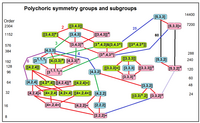Point groups in four dimensions

Point groups in four dimensions can be a little tricky to understand, but I'll try to explain it in a way that even a five-year-old can understand!
Imagine you are drawing pictures in a big, empty room. You can draw pictures on a piece of paper or in the air, but you can't touch anything in the room – it's like you're a ghost. You can draw lines, circles, and other shapes, and you can move around the room to look at your drawings from different angles.
Now, let's say you draw a square in the air. But you don't just draw one square – you draw four squares, one on each side of a cube. You might even draw lines connecting the corners of the squares together, to show that they are all connected.
This cube, with all its squares and lines, is an example of a four-dimensional shape. It has four dimensions because it has length, width, height, and something else that's hard to imagine – we call that fourth dimension "w". It's like there's another direction you can move in, but it's not up or down, left or right, or forward or back.
Now, imagine you want to see if you can rotate this cube in any way without changing the shape. That's where the point group comes in – it's like a set of rules about how you can rotate a shape without changing anything important.
For example, let's say you rotate the cube 90 degrees around one of its edges. You might think that the cube looks different now, but actually it's still the same shape – you just turned it in space. This is an example of a rotation symmetry – the cube looks the same after you've rotated it.
There are lots of different ways you can rotate the cube without changing its shape, and these different rotations form a group. We call this group the point group of the cube.
In four dimensions, the point groups can get really complicated, because there are a lot more ways you can rotate a shape without changing its shape. But the idea is the same – you're looking for all the different ways you can move a shape without changing it.
So, to sum up: point groups in four dimensions are like a set of rules for rotating a shape without changing its shape. It's like a game of "how many ways can I move this block without messing everything up?" And when you figure out all the ways you can move it, you've found the point group of that shape.
Imagine you are drawing pictures in a big, empty room. You can draw pictures on a piece of paper or in the air, but you can't touch anything in the room – it's like you're a ghost. You can draw lines, circles, and other shapes, and you can move around the room to look at your drawings from different angles.
Now, let's say you draw a square in the air. But you don't just draw one square – you draw four squares, one on each side of a cube. You might even draw lines connecting the corners of the squares together, to show that they are all connected.
This cube, with all its squares and lines, is an example of a four-dimensional shape. It has four dimensions because it has length, width, height, and something else that's hard to imagine – we call that fourth dimension "w". It's like there's another direction you can move in, but it's not up or down, left or right, or forward or back.
Now, imagine you want to see if you can rotate this cube in any way without changing the shape. That's where the point group comes in – it's like a set of rules about how you can rotate a shape without changing anything important.
For example, let's say you rotate the cube 90 degrees around one of its edges. You might think that the cube looks different now, but actually it's still the same shape – you just turned it in space. This is an example of a rotation symmetry – the cube looks the same after you've rotated it.
There are lots of different ways you can rotate the cube without changing its shape, and these different rotations form a group. We call this group the point group of the cube.
In four dimensions, the point groups can get really complicated, because there are a lot more ways you can rotate a shape without changing its shape. But the idea is the same – you're looking for all the different ways you can move a shape without changing it.
So, to sum up: point groups in four dimensions are like a set of rules for rotating a shape without changing its shape. It's like a game of "how many ways can I move this block without messing everything up?" And when you figure out all the ways you can move it, you've found the point group of that shape.
Related topics others have asked about:
